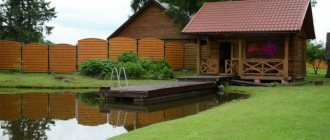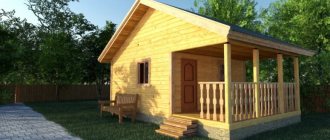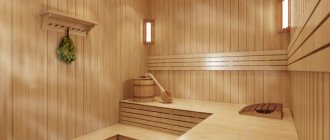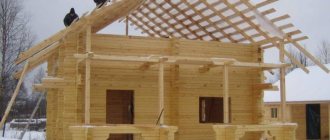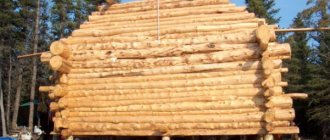There is nothing better than relaxing in a country house or country house. Especially if this vacation includes such a pleasure for the body as a bath. When thinking through a bathhouse project, it is important to take into account many nuances. This is the choice of location, building materials, the question of how to carry out interior finishing work, how to install the stove correctly, and much more. In this article we have collected information for you that will be useful at the decision-making stage. With its help, you will decide how to arrange your individual place for relaxation.
When designing a bathhouse, the following factors should be taken into account:
- location on the site, whether it will be a separate building or acts as an extension to the house;
- heater power;
- how many visitors there will be;
- wall thickness, finishing, presence or absence of insulation.
Choosing a place for a bath
There are two options for placing a bath:
- Separate from a residential building;
- Close to the possibility of entry from the house.
Most often, a bathhouse in a dacha is set up at some distance from a residential building, in the rear part of the site.
When choosing a location, it is wise to take into account the location of the water source (well, water supply). In this case, it is necessary to ensure that the building does not interfere with either the owners of the site or the neighbors.
A place in a lowland that is periodically flooded is not suitable. On a large area, the bathhouse must be located within walking distance from a residential building, taking into account the location of the main communications.
It is important to take into account building codes when determining the location for a future bathhouse:
- At least 8 m from a residential building;
- From wooden outbuildings 11-15 m;
- From structures made of non-combustible materials 6-11 m;
- At least 1 m from the fence (boundary);
- At least 5 m from a natural body of water;
- At least 15 m from the forest.
Having selected the best place to build a bathhouse, taking into account all the nuances, you need to decide on the size of the building and the design.
What areas can you build on?
The planned construction of a bathhouse is possible in areas with different categories of land use. The legislation identifies the following territories where the construction of a bathhouse is allowed:
- Plots for individual housing construction (IHC). Such territories are located in regional centers, villages, hamlets and small towns.
- Plots with subsidiary plots that are privately owned (LPH). An important nuance is that the land must be located within a populated area where the construction of a residential building is officially permitted. At the same time, the plot can be used for agricultural activities.
- Summer cottages for gardening and construction of private buildings (SNT).
In conditions of capital construction from 2 floors and connection to communications, a mandatory permit is required. It will have to be obtained before the construction of the bathhouse.
Project development
The project is easy to do yourself, taking into account the overall dimensions of the future structure. When calculating the dimensions, take into account the number of people who will be in the room at the same time. To comfortably accommodate one person you need 3 sq. m area.
At the planning stage, you should accurately determine the location of the person in the steam room. Seats will require less space than sunbeds to accommodate an adult horizontally.
In addition, it is important to think through the internal layout of the bathhouse in detail. The main room is the steam room. It can be supplemented with a shower room, a relaxation room, and a dressing room. If the area of the site does not allow you to place a spacious bathhouse, then you will have to limit yourself to a steam room and a small dressing room.
The table contains average standards for different bath options.
Independent work on the project will allow you to create the most convenient structure, taking into account various individual wishes.
Main rooms in the bathhouse
Each type of bath includes the following functional premises:
- dressing room (dressing room);
- steam room;
- washing room;
- restroom.
Dressing room (locker room)
The dressing room is also called a vestibule. Here visitors leave their clothes, brooms and firewood are stored here. The dressing room performs a number of functions :
- is a zone with a buffer function that equalizes the temperature transition from the climate outside to the temperature inside the bathhouse;
- serves as a place for drying firewood;
- often also serves as a room in which to rest.
The dressing room door should open outward.
Steam room
This room is the main, base room of the building. This is where the highest temperature is maintained and where the furnace is located. In the corner of the steam room there are stones that create steam. There should be a heat-resistant coating underneath.
There are also benches arranged on steps. Two, as a rule, are intended for sitting, one for lying. When arranging a steam room, you need to think through the nuances:
- the material with which the ceiling and walls are sheathed is characterized by certain thermal insulation properties, taking them into account, the depth of thermal insulation of the rooms is calculated, and constructive techniques are used;
- The effective operation of the ventilation system is ensured by a special box or swinging window with double glazing. The location of the window is opposite the stove;
- the doorway is designed with a higher threshold: this way, cool air does not pass under the door and thermal efficiency is not reduced. The door itself swings outward;
- The steam room and washing room must be separated, otherwise the quality of steam and temperature decreases and fuel consumption increases.
Wash room
The washing room, often a shower stall, is located near the steam room . If the size of the building allows, these zones are separate from each other; in small buildings they are combined. In large buildings, a swimming pool or plunge pool is also equipped here.
The average area of the washing room is 2000x2000mm, then there is a place to take water procedures and place containers with water, hot and cold.
The window is built one and a half times larger than the window in the steam room. The doorway has also been enlarged – 1800x800mm to provide greater comfort. The requirements for heat conservation are lower than in a steam room. The threshold is made high, and the floor is laid with special tiles to prevent slipping and related injuries.
Restroom
Designs of bathhouses with a relaxation room give room for imagination. When there is only one recreation room, it can be made multifunctional through zoning . Eating, drinking tea, watching TV, billiards - all this happens in one room. Zoning is done using partitions, windows, furniture, and finishing materials. Additional comfort will be created by a fireplace in the corner and a couple of armchairs in front of it.
Small bathhouse project
Typically, summer cottages do not have a large area, so a mini bathhouse is a way out. Inside, the room consists of a dressing room and a steam room. The optimal solution would be a room of 4 x 4 m.
You will need to develop a detailed drawing with an exact indication of the area of each room, ceiling height, placement of the stove, doors, windows, light bulbs and sockets.
It is important to know that the window opening in the steam room is placed at a height of 185-195 cm from the floor surface. A similar bathhouse project would be a good option.
In this case, it is not difficult to adjust the sizes of the internal rooms relative to each other.
A carefully thought-out project and detailed drawing will help you accurately calculate the amount of building materials needed. Photos of a bathhouse in the country will help you decide on the appearance of the structure.
Options for interior design and layout
Previously, a bathhouse could consist of one room. Nowadays, a classic bathhouse consists of several rooms, each of which performs its own task .
Thanks to the zoning of the premises, the steam room warms up faster, while the rest room has a normal temperature. It should be easy to enter all rooms from the dressing room.
The interior arrangement of a bathhouse depends primarily on its type . The washing room and steam room can be equipped in the same room if it is a Russian bathhouse, and must be separated if it is a Finnish version. If the building has a swimming pool, then a steam room, a relaxation room and a washing room should open into the room with it - this option will be optimal.
The bathhouse, equipped with a veranda with barbecue, will become a favorite place for the family and its guests. The recreation room can accommodate not only a billiard room, but also a hookah room.
A successful design would be bathhouse projects with a relaxation room and a terrace . Here you can relax inside during the cold season or enjoy nature on the terrace in summer. We offer a mini review of bathhouse projects with a terrace.
The selected project for a bathhouse with a swimming pool will be a wonderful place to relax.
An interesting option would be a bathhouse with an attic and a balcony in it. A gable or sloping roof is suitable for such a project. It can be coated with ondulin, which will ensure the strength of the roof and the durability of the entire building.
When designing a bathhouse, you should consider some important points:
- room layout;
- water supply system;
- wiring of the electricity network;
- sewerage and drainage system.
A convenient option would be a bathhouse, in which there will be an exit from the dressing room or rest room to the terrace, and the stove can be located in the rest room and serve as a fireplace
Selection of building materials
There is no strictly limited list of materials suitable for building a bathhouse in the country. Can be used:
- Tree;
- Brick;
- Aerated concrete blocks;
- Cinder blocks;
- Expanded clay concrete;
- Arbolit.
The seasonality of using the bathhouse should be taken into account. For year-round use, it is wise to take care of reliable thermal insulation. For the summer version, you can do without it.
Traditionally, wood is used to build a bathhouse. This can be a log house or a structure made of timber. A wooden bathhouse warms up quickly, the material is environmentally friendly and easy to use.
The construction time for a wooden bathhouse is quite short, and the ventilation in it is excellent.
Types of modern baths include frame structures. Frame baths are assembled from ready-made beams of various sections according to the project. A material with high thermal insulation qualities is used as insulation.
External cladding is performed using edged boards, block houses, siding, and OSB panels. For interior decoration, the most popular material is lining. The undoubted advantage of frame baths is their cost and assembly time.
Brick baths are very common. Brick is durable, fireproof, and, unlike natural wood, does not require protective treatment. The disadvantages of its use include the need to fill a strip foundation, the duration of construction, and the cost of the material.
You should know that it will take more time to warm up such a structure compared to a wooden structure, and the ventilation in it is noticeably worse.
Among modern materials suitable for building a bathhouse with your own hands, it is necessary to note gas blocks and foam blocks (expanded clay blocks).
You should know that aerated concrete blocks require a special adhesive composition, while expanded clay concrete blocks can be planted on ordinary cement mortar. The blocks are lightweight, which allows you to do the work alone.
Procedure for registering a constructed facility
The bathhouse requires mandatory state registration as a real estate property. Only in this case does the owner have ownership rights to the building.
Any bathhouse needs registration - one built with a permit or one for which it is not required.
The decision to register depends on the moment of construction . If there is a notification and an act from the administration, they are submitted along with other documents to Rosreestr.
If the bathhouse was built without permission without the permission of the local administration, it can be registered according to a simplified scheme in the form of a dacha amnesty. This opportunity is established in accordance with Federal Law No. 93 of June 30, 2006.
You can register a bathhouse in one of the following ways:
- in person through a multifunctional center or a territorial department of Rosreestr;
- online through the website of Rosreestr and State Services;
- by mail.
When submitting an application through the Rosreestr website, you must complete the following steps:
- Select the service “Submit an application for state registration of rights.”
- Go to the “Registration of Property Rights” section. Here you can select the appropriate section - registration of the right to the sole owner, common shared or joint ownership.
- Fill in the information about the building by selecting the “non-residential premises” field. Indicate the cadastral number and area of the property, location address. Enter the personal information of the owner and his contact address.
- Fill in information about the copyright holder and consent to data processing.
- At the next stage, attach electronic versions of documents.
At the final stage, documents are sent for registration online . This option is suitable for owners of an electronic digital signature.
This is a time saver and does not require you to go in person when submitting your application. If after the inspection no violations are identified, an extract from the Unified State Register of Entry of data into the register is provided.
You can also submit documents via mail. In this case, copies of documents certified by a notary are sent. A response can also be requested by mail.
When applying in person to Rosreestr or MFC, documents are submitted in copies. An employee will check the originals for consistency. A receipt for receipt of documents and applications is provided. The date of the return visit is indicated. During your next visit, you can receive an extract with registration information.
The package of documents for registration includes the following:
application or declaration in the case of a non-permanent structure;- owner's civil passport;
- title document for the land and an extract from the Unified State Register of Real Estate;
- boundary plan;
- technical plan;
- building permit (not required if the construction is not permanent);
- receipt of payment of state duty - 350 rubles for a light structure, 2000 for a bathhouse built with a permit.
An employee of Rosreestr will formalize the construction within 7-10 days. Based on the results of the work, the data is entered into the state register, about which the owner receives an extract from the Unified State Register.
Materials for interior finishing
It is recommended that the rest room and dressing room be decorated inside with materials that have a low degree of thermal conductivity. Alder, linden or aspen are good for this purpose.
Wooden lining is usually used for the walls and ceiling in the steam room, since it can withstand prolonged exposure to high temperatures. It is not recommended to use softwood due to its ability to release resin. Wood derivatives (fibreboard, chipboard) can emit harmful substances, so they must also be discarded.
Having studied the photo of the bathhouse inside, it is easy to decide on the options for the interior decoration of the bathhouse.
Conclusion
The distance from the bathhouse to residential and non-residential buildings, water supply sources, site boundaries and other objects must comply with the requirements of SanPin and SNiP. This indicator depends on the characteristics of specific objects, construction materials, number of storeys of buildings and the type of engineering systems. Regional requirements may make regulations more stringent. It is recommended to think through these nuances in advance and create a project taking into account current legislation. In order not to face a refusal to approve the project, you can entrust the task to experienced specialists who know the intricacies of modern legislation and its latest changes.
Construction of a bathhouse
The first stage in the work is marking the construction site of the building. To do this, it is convenient to use a rope and pegs.
The next step will be the arrangement of the foundation, the type of which directly depends on the building materials used. Most often, a strip foundation is used, placing it along the perimeter of the walls and under internal partitions.
For a frame structure, a columnar or screw foundation is sufficient.
After the foundation has been laid out, the construction of walls begins: brickwork is done, a log house or frame structure is erected.
The construction of a frame bath involves the use of boards, timber and insulation. The insulation of the walls is carried out during the installation of the roof. This will help protect the materials from moisture.
The floor in the room is insulated and a floorboard is laid. The use of additional wooden panels as flooring will serve as a reasonable solution for a bathhouse in the country. It’s easy to take them out of the bathhouse into the utility room for additional drying, leaving the dacha until the next weekend.
Do I need to receive it?
In accordance with Part 6 of Art. 1 Federal Law No. 218 of July 13, 2019 “On state registration of real estate” and Art. 130 of the Civil Code of the Russian Federation, bathhouses with a foundation belong to the category of capital buildings and require registration. In this case, a construction permit and project approval are required.
A construction notice is submitted in the following cases:
- the bathhouse is planned as an extension to the cottage;
- the bathhouse includes a relaxation room with a sleeping place;
- a bathhouse complex for commercial use is planned.
In the latter case, it is necessary to obtain a full permit for the construction of the facility.
Additionally, a project is being prepared; permission from neighbors is required. Coordination with such authorities as SES and Rosnedra is necessary.
As a separate building
A compact, lightweight building with a non-buried foundation does not require permission .
At the same time, communications should not be connected to it. A bathhouse without a permanent foundation can be installed on a SNT, individual housing construction or private plot plot. A permit will be required if the building has a permanent foundation and communications are connected to it - water supply, sewerage, electricity.
This category includes two-story buildings and options with an attic , where a recreation room with a sleeping place is provided.
If you plan to build a commercial bathhouse, you will need additional permission from the fire inspectorate and sanitary and epidemiological station. Only after this can you conduct business legally.
As an extension to a residential building
If the house was built previously, a permit will be required. It is necessary to submit a new building project for consideration to the administration.
In this case, the following parameters are taken into account:
- increase in area;
- compliance with fire and sanitary requirements;
- maintaining the safety margin of the walls and foundation.
This requirement applies equally to personal use and to a commercial bathhouse. In the latter case, the conclusions of the SES and fire inspector are required.
Ventilation arrangement
A well-equipped ventilation system will allow you to fully ventilate the room to avoid the formation of fungus and mold.
The air inlet is located at the bottom of the wall next to the heating boiler. The exhaust vent is located on the opposite wall, right under the ceiling.
During heating of the bath, the exhaust hole must be closed. Open it when it is necessary to ventilate the room.
Do-it-yourself bath step-by-step instructions
Step I - preparing the place you have chosen
You will need to remove all debris, bushes, stumps and anything else that will get in the way when working on the foundation.
Step II - building the foundation
If you have a bathhouse made of timber, then a columnar foundation is suitable for it; it is not expensive and is excellent for the construction of small wooden and frame structures.
To create it, you need to dig a certain number of holes for installing supports. We will now calculate how many holes we will need as follows - supports are placed in the corners and at the intersections of the walls of the structure and with a certain step along the perimeter.
View this post on Instagram
Publication from HOUSE.BATH.STAIRS.SYNDICAT (@syndicat_individual)
To choose the right step, you need to take into account the type of soil and the total load of your structure. The depth of the hole should be 1-1.5 m; the depth of freezing in your area also depends and it can affect the depth of the funnel. The material you need is asbestos-cement pipes and fittings.
Fill the bottom of the funnel with a mixture of sand and gravel about 10-15 cm. Then install an asbestos-cement pipe of the required length into the hole vertically and secure it. Place the reinforcement rods inside the pipe and secure them.
Then prepare a cement mortar and pour it into the hole and into the pipe itself. After you have poured the concrete solution, wait about a couple of days for the concrete to completely harden. Then lay out a wall about half a brick thick between your pillars.
View this post on Instagram
Publication from Vladimir STROY/Building houses. (@vladimir.stroy)
Step III - Construction of walls and roofing
The standard material for the construction of walls is timber measuring 150x150 mm. Before installation, you must install waterproofing. You need to treat the lower part of the beam with an antiseptic. Often laying timber is the “Into the paw” method
You need to make the first installation even to the geometric parameters - all your angles must be strictly 90 degrees. When you lay out a wall, do not forget about the future of windows and doors, do not forget to insulate each row of timber with heat-insulating material. Use metal or wooden pins to connect the beams to each other.
After the walls have been erected, proceed to the roof. You need to fix the rafters, which are attached to the upper crown with brackets.
If you are installing a single-pitched roof, then the supports are secured either with two external ones, or with one external and one internal support. When choosing a gable roof, you need to fasten the rafters so that all support is on the wall, and connect them together from above.
You mount boards across the fixed supports (lathing), then lay insulation, waterproofing, and vapor barrier. The final stage of our roof is that all that remains is to lay the roofing material you have chosen.
Step IV - Interior work
The first step in interior decoration is to start with communications - water, sewerage, electricity.
It is necessary to lay the sewer system at the stage of drawings or construction of the foundation. Next to your future bathhouse, you need to dig a drainage well into which a sewer pipe will be laid at an angle from the bathhouse to remove wastewater from the washing compartment.
After completing installation work with the sewerage system, we make a finishing floor; it is usually made of wood or concrete. A concrete floor will last longer and is most often covered with tiles or porcelain tiles.
If you choose a wooden floor, then such a floor must be made to leak, the boards must be made with a small gap so that the water can drain, or a small drain must be made in the floor. Make the floor with a slight slope towards the drain.
Then you need to insulate and vapor barrier the walls and ceiling using the materials you have chosen. Make high-quality wiring and plumbing.
Next, we install windows and doors, and perform final finishing using lining or other materials. After completing the interior decoration, install the necessary electrical appliances that you have chosen.
Step V - Installation of the Oven and Shelves
There are many ways to place shelves, keep the correct dimensions, they need to be made from hardwood. Installation is easy - create a frame from timber and attach boards to it.
The installation of the stove must comply with all fire safety regulations. Wooden devices should not be exposed to the high temperature of the stove and chimney. If the stove is heavy, it needs a foundation.
You choose the oven according to your preferences. This is a standard stove on stones and wood, an electric or even a gas stove for a bath.
Factory baths
As an option, you can consider purchasing a prefabricated bathhouse. Having studied the project from the manufacturer, it is easy to purchase a complete set of already fitted parts. The kit comes with detailed instructions for performing the work, as well as a complete set of necessary accessories.
Ready-made bathhouses in the country are an ideal solution when there is no time to do the construction yourself. The variety of projects allows you to choose the best option for any family.
When ordering such a bathhouse, you will need to prepare the site and take care of communications. The dimensions of the finished turnkey bathhouse are limited by the size of the transport for its transportation. For this reason, its dimensions cannot be more than 7 X 2.3 m. Installation of the structure will take several hours.
The difference in the cost of a bathhouse built independently and a ready-made structure is compensated by the savings in time to complete all the necessary work.
Documentation
It is necessary to prepare the following set of documents:
notification of the beginning and completion of construction (for an extension to a house);- application in the prescribed form;
- document of title to land (sale and purchase agreement, gift, certificate of inheritance);
- extract from the Unified State Register of Real Estate;
- site plan;
- development plan with reference to the area and indicating the distance to the main objects on the site.
In the case of construction of a commercial bath complex, a permitting act is submitted instead of a notification. For this purpose, design documentation is prepared, including a diagram, explanatory note, description of building materials, heating systems, and drainage. drainage, septic tank. Approval is obtained from the local administration.
Documents are transmitted in the form of copies and originals . The receptionist will take copies and issue a receipt indicating the date of the next appearance.
Photo of a bathhouse in the country
Making the foundation
Mini-bath, do-it-yourself sauna
As soon as you have decided on the plan and dimensions of the mini-bath for your dacha, you need to start considering the foundation. For a small room with frame walls there is no need for a powerful foundation, but its type will depend on the location of the bathhouse and the type of soil on the site.
First, you need to clear and clean the area where construction will take place. We get rid of weeds to facilitate excavation work, after which we carry out markings. By calculation it is necessary to determine the diagonal and check it by measuring the distance between the corners: they must be equal, in which case we will get right angles.
Marking the construction site
Marking the trench for the foundation
We stretch the string between the pegs, then step back a distance the width of the foundation and secure four more pegs in the corners. For sandy soil, take 40 cm, for clayey soil - 25 cm. Next, a trench is dug, the depth of which is approximately 50 cm. If your design includes a partition, you also need to build a foundation under it. Sand is placed at the bottom of the trench in a layer of 10 cm. Sometimes gravel is used, which must be leveled and compacted well.
1 3
Taking a metal rod with a diameter of 10 mm, a lattice is made for a reinforced concrete structure. Using boards or sheets of plywood, we construct formwork, the height of which is about 20 cm. The metal lattice should be 10 centimeters narrower than the width of the trench; it must be laid using special brick linings. The next step will be making the solution. The finished solution is poured into the trench, and the top is leveled with a trowel, after which it is necessary to wait a certain time for the foundation to harden. It is worth placing waterproofing material on top of the reinforced concrete structure.
Grating for reinforced concrete structure
Formwork for pouring the foundation
Strip foundation
Sometimes a columnar foundation is used: in this case, the filling occurs not in a continuous layer, but in segments. Supports are placed every meter. If you plan to use a heavy stove, you also need to pour a foundation under it.
Columnar foundation is suitable for small buildings
